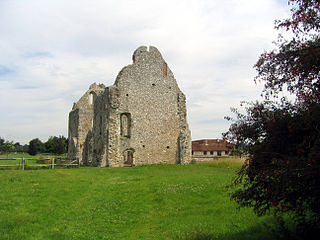
The dissolution of the monasteries, occasionally referred to as the suppression of the monasteries, was the set of administrative and legal processes between 1536 and 1541 by which Henry VIII disbanded monasteries, priories, convents, and friaries in England, Wales, and Ireland, expropriated their income, disposed of their assets, and provided for their former personnel and functions. Although the policy was originally envisaged as increasing the regular income of the Crown, much former monastic property was sold off to fund Henry's military campaigns in the 1540s. He was given the authority to do this in England and Wales by the Act of Supremacy, passed by Parliament in 1534, which made him Supreme Head of the Church in England, thus separating England from papal authority, and by the First Suppression Act (1535) and the Second Suppression Act (1539). While Thomas Cromwell, Vicar-general and Vice-regent of England, is often considered the leader of the Dissolutions, he merely oversaw the project, one he had hoped to use for reform of monasteries, not closure or seizure. The Dissolution project was created by England's Lord Chancellor Thomas Audley, and Court of Augmentations head Richard Rich.

Boxgrove Priory is a ruined priory in the village of Boxgrove in Sussex, England. It was founded in the 12th century.

Wenlock Priory, or St Milburga's Priory, is a ruined 12th-century monastery, located in Much Wenlock, Shropshire, at grid reference SJ625001. Roger de Montgomery re-founded the Priory as a Cluniac house between 1079 and 1082, on the site of an earlier 7th-century monastery. In 1101 bones, believed to be those of Saint Milburga, were discovered beneath the floor of the old church. The relics were ceremoniously translated to the main monastery church.

Fischingen Abbey, now Fischingen Priory, is a Benedictine monastery situated in Fischingen in the Canton of Thurgau, Switzerland, on the upper reaches of the Murg, a tributary of the Thur. It was founded in 1138, dissolved in 1848 and re-founded as a priory in 1977.

St Bees Priory is the parish church of St Bees, Cumbria, England. There is evidence for a pre-Norman religious site, and on this a Benedictine priory was founded by the first Norman Lord of Egremont William Meschin, and was dedicated by Archbishop Thurstan of York, sometime between 1120 and 1135.

Cardinham Grange was a monastic grange in Cardinham, Cornwall, UK. Lady Vale Chapel was given soon after the Norman Conquest by Richard Fitz Turold to the Abbey of St Mary de Valle near Bayeux intending that a cell of monks should be established. The abbey, finding the property burdensome, induced Richard to transfer it to the monastery of Tywardreath which he was then founding. It was served by monks from Tywardreath until the dissolution of the monasteries when the property was granted to the Duchy of Cornwall.

Various monasteries and other religious houses have existed at various times during the Middle Ages in the city of Exeter, Devon, England.

Otterton Priory was a priory in Otterton, Devon founded before 1087 and suppressed in 1414. The tower of the parish church is the major remaining structure of the monastery. The manor house probably reuses parts of the monastery's fabric.
Totnes Trinitarian Priory, also known as the Trinitarian hospital of Warland was a medieval monastic house in the town of Totnes in Devon, England. It was founded in 1271, and dissolved in 1509.

Wilmington Priory was a Benedictine priory in the civil parish of Long Man, East Sussex, England. The surviving building is now owned by the Landmark Trust and let as holiday accommodation. It is both a Grade I listed building and a scheduled monument.
Catley Priory was a monastic house in Walcott, Lincolnshire, England.

St Bartholemew's Benedictine Priory, Sudbury was a priory in Sudbury, Suffolk, England.

Wroxall Priory was a medieval monastic house in Wroxall, Warwickshire, England.
Sele Priory was a medieval monastic house in Upper Beeding, West Sussex, England.

Pill Priory is a Tironian house founded near Milford Haven, Pembrokeshire, South West Wales in the late 12th century.











